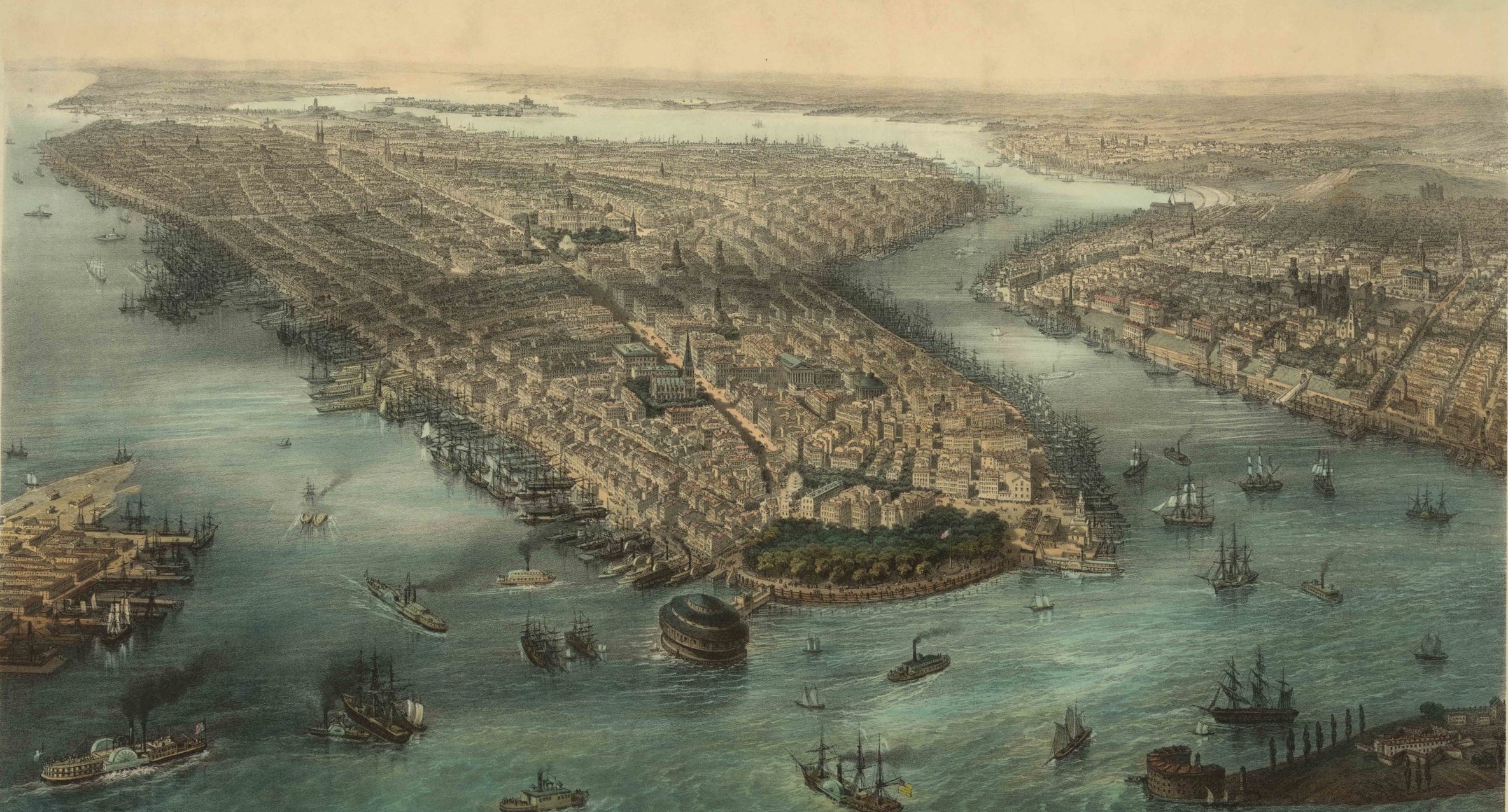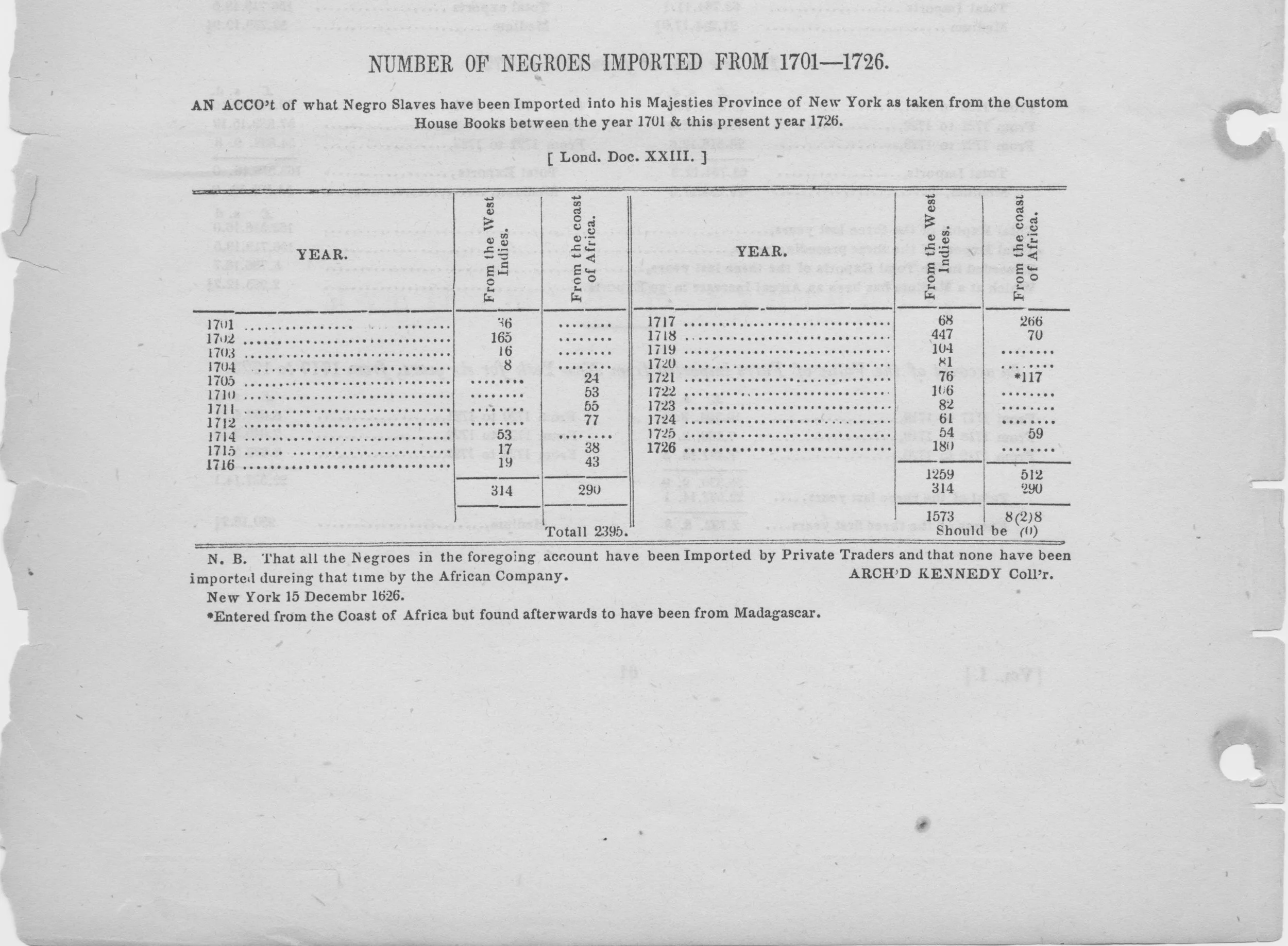A SHORT HISTORY OF SLAVERY IN NYC
New York City bird’s-eye view, 1850s. Purchase a fine-art print.
Illustration of the first slave auction in New Amsterdam, which took place in 1655.
New York City has long been known for its diversity and progressive values – the city of immigrants, birthplace of the Harlem Renaissance, but the city has a barbaric past from the slave market of Wall Street to draft riots in 1863 where innocent black New Yorkers were attacked ending in a death toll of over a hundred. The sale and keeping of slaves in New York City was common since its founding and it wasn't until 1841 that New York State finally abolished the practice. In 1991 when Federal Plaza was being constructed in Lower Manhattan, an excavation found intact human skeletal remains located 30 feet below Broadway, a 6-acre burial ground containing upwards of 15,000 intact skeletal remains of enslaved and free Africans who lived and worked in colonial New York. Now a public monument, the African Burial Ground is a reminder of the city’s history that is often neglected.
Slavery was introduced to New York City when the Dutch settled the colony, bringing with them 11 African men in 1626 and three women in 1628. When the English captured the city in 1664 nearly 9% of the 8000 settlers were Africans (slaves and freed) and their ownership was transferred to the British who institutionalized slavery, classifying them as chattel that worked involuntarily. In British New York City, killing a slave was illegal, but unlike the Dutch who had allowed slaves to marry in church, under the British they could not be married and families were split up.
Slavery continued to be an important source of the city’s labor force into the early 18th century, with 40 percent of white households owning slaves, making New York the largest slave-owning colony in the north. In 1711 a slave market was established at the foot of Wall Street. The market was located at the present-day intersection of Wall and Water Streets, then at the water’s edge, and was intended for the hiring, buying, and selling of slaves. It became known as the Meal Market, the official public market for goods including corn and grain, with slaves continuing to be bought and sold.
Slave Market at the foot of Wall Street, 1730s.
By this time 20% of the city's population was enslaved blacks. On April 6, 1712, nine white New Yorker's were killed in what would become the city's first slave uprising. On April 6, 1712, twenty-three enslaved blacks armed with guns and knives set fire to a building on Maiden Lane. When the fire soon spread, the slaves attacked the white colonists who rushed to put the fire out, killing nine of them. British soldiers dispatched militia units and soon captured the twenty-three slaves. Six off the captured committed suicide, but the rest were executed, most burned alive. Laws were quickly established following the revolt making it illegal for slaves to meet and allowing slave owners to punish their slaves as they saw fit. But not even forty years later there would be another slave uprising in New York City.
British custom records showing the number of slaves imported to New York between 1701 and 1726.
Between 1700 and 1774 the city legally admitted around 6,800 slaves, with prominent NYC families such as the Schuylers, Livingstons, Van Cortlands, Beekmans and Waltons profiting from the trade.
In 1741 a slave uprising burned down homes, businesses, the seat of the royal government, the walls of the Governor’s residence at Fort George (the Battery). The uprising lasted six months and resulted in the execution of 30 black men and the deportation of 72. After the decade of the 1740s – when New York would have the second largest slave population in the Thirteen Colonies – Manhattan’s slave population would peak at 21% before starting a slow decline leading up to the Revolution. The slave market on Wall Street wasn’t dismantled until 1762.
After the war, more prominent white New Yorkers began to push for gradual emancipation and in 1799 children of slaves were free. In 1809, marriage between slaves was legalized with separation of families prohibited. In 1827, New York State Governor Tompkins abolished slavery, but complete abolition was not achieved until 1841 when the state revoked a law that made nonresidents able to hold slaves for up to 9 months. But the city still held ties to southern slaveholding states until the Civil War and blacks were often kidnapped in the street and transported to the South for sale.
The city profited enormously from slavery, so much that in leading up to the Civil War Mayor Fernando Wood originally proposed secession rather than loose profits from the cotton trade with the South.




